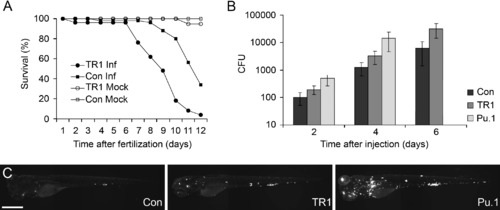Fig. 1
|
TR1 Morphant Embryos Are More Susceptible to Mycobacterial Infection (A) Control (Con) and TR1 morphant embryos were either mock injected (n = 30 each) or infected with 108 ± 11 colony forming units (CFU) of M. marinum on 1 dpf (n = 50 each). Data are plotted as the percentage of surviving embryos on each day. TR1 morphant embryos are significantly more susceptible to infection with M. marinum than controls (Hazard ratio 5.7, p < 0.0001, Kaplan Meier method with log-rank [Mantel-Cox] test). Survival was not statistically different between mock-injected TR1 and control embryos. (B) Mean bacterial loads per embryo for control (Con), TR1, and Pu.1 morphant embryos at 2, 4, and 6 days post injection (dpi) with 70 ± 13 CFU. p < 0.0001 by one-way ANOVA. Data for Pu.1 embryos are only available for 2 and 4 dpi because of mortality. Error bars represent standard deviation from the mean. All morphant bacterial loads are significantly different from one another (p < 0.05) at each individual time points (control versus TR1, control versus Pu.1, and TR1 versus Pu.1) by Student's unpaired t test. (C) Representative pictures of control, TR1, and Pu.1 morphant embryos at 4 dpi with fluorescence representing bacterial load. The scale bar represents 500 μm. |
| Fish: | |
|---|---|
| Condition: | |
| Knockdown Reagents: | |
| Observed In: | |
| Stage Range: | Protruding-mouth to Days 7-13 |
Reprinted from Immunity, 29(2), Clay, H., Volkman, H.E., and Ramakrishnan, L., Tumor necrosis factor signaling mediates resistance to mycobacteria by inhibiting bacterial growth and macrophage death, 283-294, Copyright (2008) with permission from Elsevier. Full text @ Immunity

